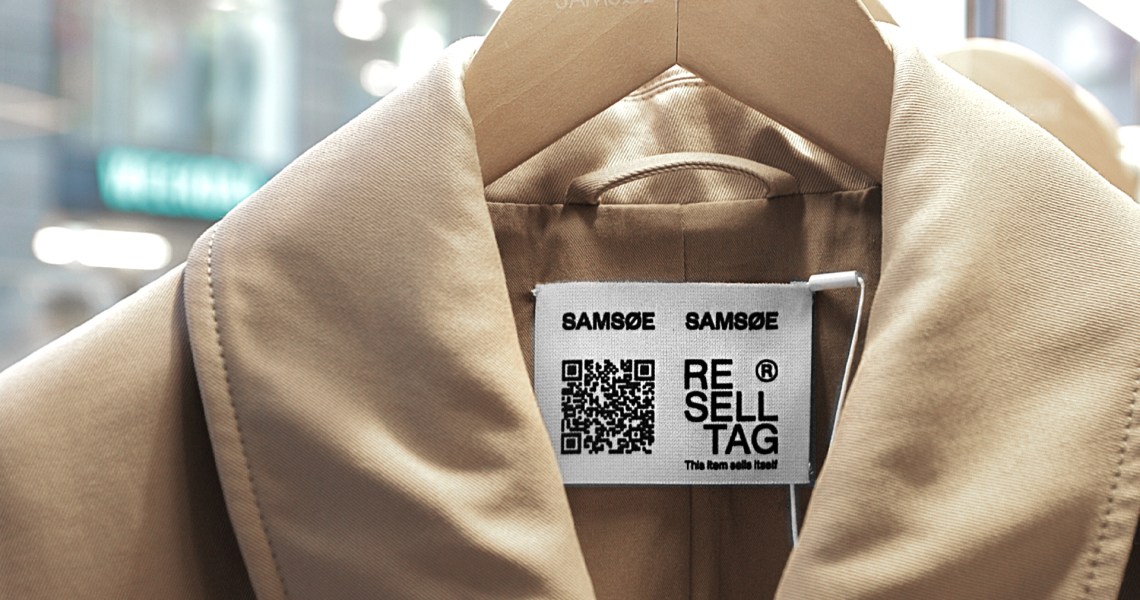Fashion brand Samsoe Samsoe is expanding its sustainability focus by adding QR tags to its clothes. Facilitating easier resale through Meta’s marketplaces is the goal.
Samsoe Samsoe, launched in Copenhagen by brothers Klaus and Preben Samsoe in 1993, has 45 brick-and-mortar stores across multiple countries, including Denmark, the U.K. and Germany. It currently sells all over Europe, the U.S., Canada and Australia, including through Nordstrom in the U.S. It also sells through wholesale partners and has more than 1,500 stockists worldwide. It brought in more than $127 million in revenue in 2021, and its prices range from $19 for accessories to $750 for a coat. The brand has been increasingly investing in sustainability initiatives since 2019.
Sewn into the clothes, its new resell tag is connected to Meta’s marketplace on Facebook and Instagram. According to Lars Samuelsen, Creative Chairman & Chief Strategy Officer at Uncle Grey, “It’s a seamless process that has been automated as much as possible. [It will] leverage a range of data sources to automatically produce a product post when the QR code is scanned. At the same time, it will activate the brand’s ‘in-clothing media budget,’ [which pays for the] post to run across Facebook and Instagram.” That data includes the piece’s style, price, size, picture, location and date of purchase.
There is no partnership with Meta — all transactions happen directly between the seller and buyer; neither Samsoe Samsoe nor Meta will take an active roll in the exchange nor will they take a fee from the buyer or seller. The brand is only involved in leveraging its data to inform the listing, with the consumer being responsible for shipping and further developments.
The idea for the QR code was born during meetings with Uncle Grey, which the brand began working with two months ago to develop its product life cycle initiatives.
“We believe [Samsoe Samsoe’s] pieces are both of significant quality and timelessness for them to be worn for years and years,” said Samuelsen. “The brand is always pushing to become even more responsible in the way they operate and getting maximum usage of clothing that has been produced has been overlooked.”
For Samsoe Samsoe, the stitched-on QR code perfectly aligns with those initiatives. “We see it as a brilliant idea to increase the lifecycle of our products. It’s not just about being sustainable in how you produce, but it’s also about being sustainable in how long your products last and will be worn,” said Peter Sextus, CEO of Samsoe Samsoe.
Ad position: web_incontent_pos1
The QR feature will initially be tested across 25 clothing styles sold in the brand’s stores in Denmark. Then, once the brand tests and perfects the process, the feature wll be rolled out across its international markets, added to 100% of its garments. The wider implementation timeline will depend on how quickly the testing will be complete, but the team is aiming for the end of the year.
As the number of resale platforms grows, the motivation for a free resell service provided by the brand is convenience. With almost no input needed from the consumer, the process is as simple as purchasing a garment, making it easier and quicker for the process to start. As Facebook Marketplace registered more than 1 billion monthly global users in the first quarter of 2021, it’s an appealing platform to target.
“We try to be as dynamic as possible, and we are always trying to challenge how the industry is working,” said Sextus. “With our tag, there is no commission. We just provide [consumers] with the data of the product, and then they can put it on Facebook and resell it there.”
The brand’s marketing strategy has been focused on media close to a purchase, like social media and store displays. It’s targeting the brand’s main audience: fashion-conscious males and females ages 20-45. With expansion plans for its stores across Western Europe, East Asia and the U.S., in the next couple of months, Samsoe Samsoe wants to bring its sustainability mission to a wider audience with a focus on Scandinavian design.
According to independent campaigning network Greenpeace, clothing is significantly underworn. Worldwide, people waste an estimated $500 billion per year on clothing that goes unworn. A 2020 report from management consultancy McKinsey and the Global Fashion Agenda found that resale, repair and recycling will need to play into one in five garments by 2030 to be in line with a 1.5°C pathway. That means brands must also consider the life cycle of their products after they’ve left the shelves.




